Brit-Tech: Enhancing Business Communication & Cultural Awareness
VerifiedAdded on 2023/06/13
|12
|2442
|97
Report
AI Summary
This report delves into the critical aspects of business communication within Brit-Tech, a wholesale dealer of electronic and telecommunication equipment in Bromley, England. It identifies key challenges to effective communication, such as the inability to listen, lack of transparency and trust, and cultural and language differences, and proposes strategies to overcome these barriers, including active listening, specific information delivery, feedback solicitation, and demonstration of cultural awareness. The report also analyses organisational communication theories, including Max Weber's Communication Theory and Tompkins's and Cheney's Theory, to understand the communication structure within the company. Furthermore, it evaluates various barriers preventing employees from returning to the office, such as physical, emotional, organisational structure, perceptual, and interpersonal barriers, and suggests strategies like clarifying ideas, communicating as per receiver needs, being aware of language and tone, and establishing a democratic organisational structure to foster effective communication. The report concludes that addressing these challenges and implementing the proposed strategies is essential for aligning employee goals with organisational objectives and creating a healthy, productive working environment. Desklib provides access to this report and other solved assignments to aid students in their studies.
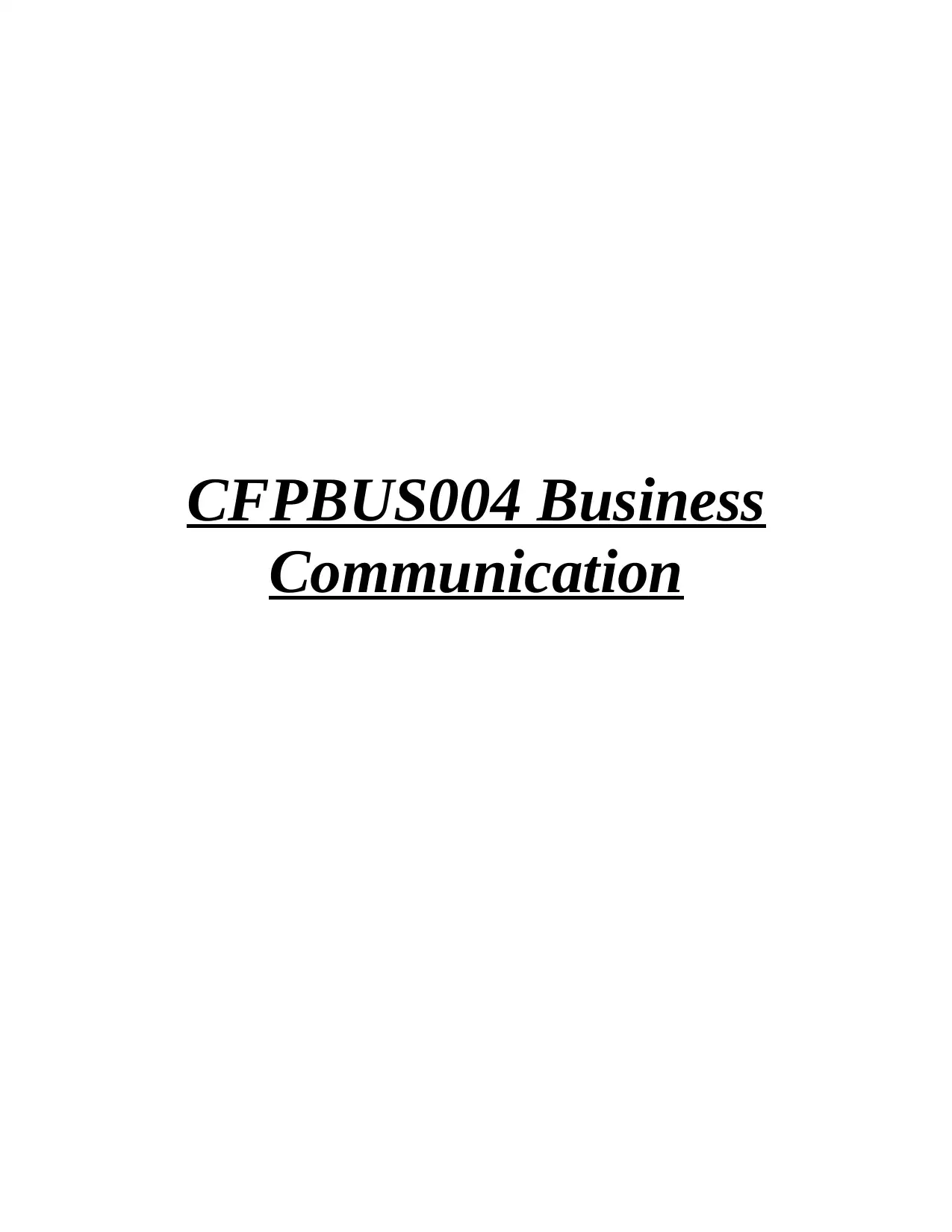
CFPBUS004 Business
Communication
Communication
Paraphrase This Document
Need a fresh take? Get an instant paraphrase of this document with our AI Paraphraser

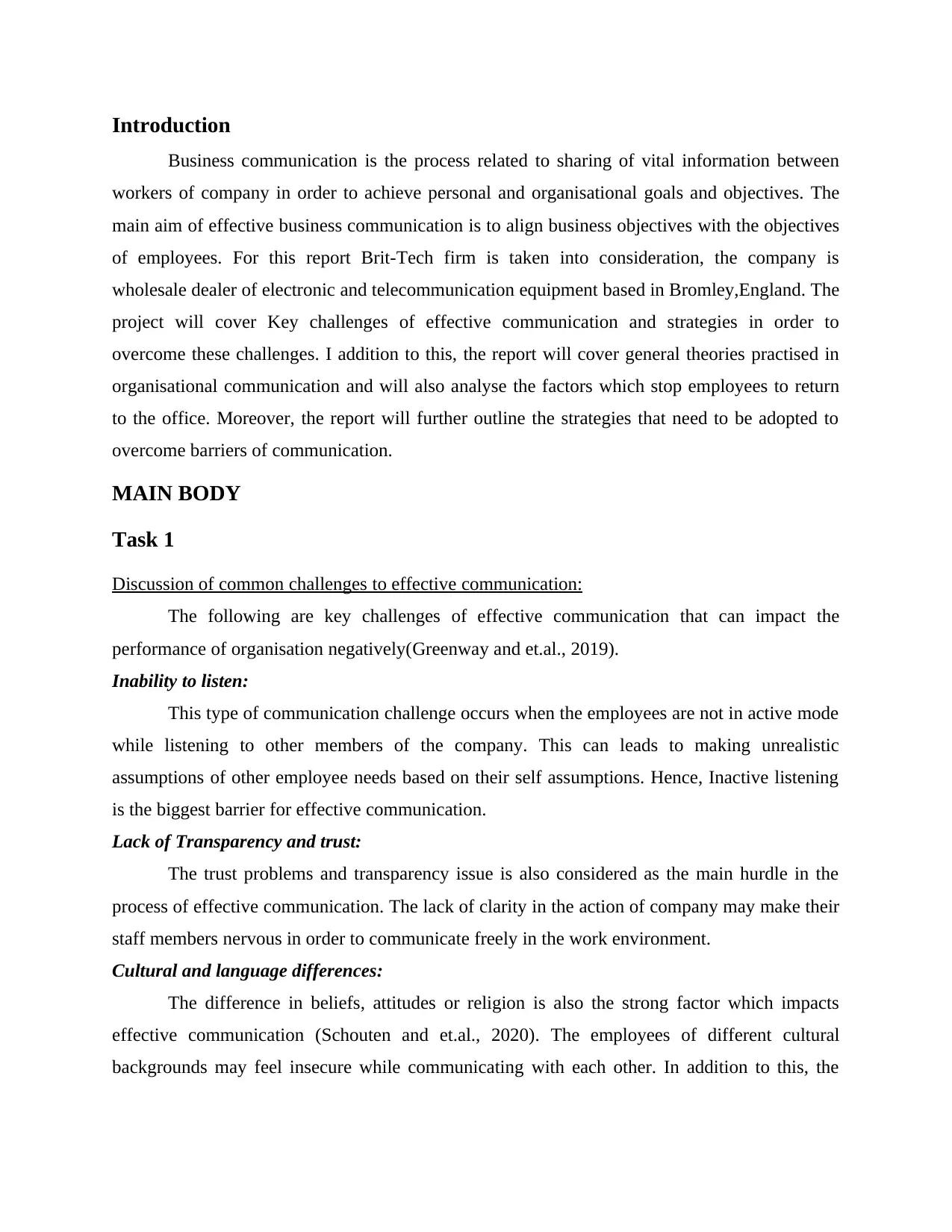
Introduction
Business communication is the process related to sharing of vital information between
workers of company in order to achieve personal and organisational goals and objectives. The
main aim of effective business communication is to align business objectives with the objectives
of employees. For this report Brit-Tech firm is taken into consideration, the company is
wholesale dealer of electronic and telecommunication equipment based in Bromley,England. The
project will cover Key challenges of effective communication and strategies in order to
overcome these challenges. I addition to this, the report will cover general theories practised in
organisational communication and will also analyse the factors which stop employees to return
to the office. Moreover, the report will further outline the strategies that need to be adopted to
overcome barriers of communication.
MAIN BODY
Task 1
Discussion of common challenges to effective communication:
The following are key challenges of effective communication that can impact the
performance of organisation negatively(Greenway and et.al., 2019).
Inability to listen:
This type of communication challenge occurs when the employees are not in active mode
while listening to other members of the company. This can leads to making unrealistic
assumptions of other employee needs based on their self assumptions. Hence, Inactive listening
is the biggest barrier for effective communication.
Lack of Transparency and trust:
The trust problems and transparency issue is also considered as the main hurdle in the
process of effective communication. The lack of clarity in the action of company may make their
staff members nervous in order to communicate freely in the work environment.
Cultural and language differences:
The difference in beliefs, attitudes or religion is also the strong factor which impacts
effective communication (Schouten and et.al., 2020). The employees of different cultural
backgrounds may feel insecure while communicating with each other. In addition to this, the
Business communication is the process related to sharing of vital information between
workers of company in order to achieve personal and organisational goals and objectives. The
main aim of effective business communication is to align business objectives with the objectives
of employees. For this report Brit-Tech firm is taken into consideration, the company is
wholesale dealer of electronic and telecommunication equipment based in Bromley,England. The
project will cover Key challenges of effective communication and strategies in order to
overcome these challenges. I addition to this, the report will cover general theories practised in
organisational communication and will also analyse the factors which stop employees to return
to the office. Moreover, the report will further outline the strategies that need to be adopted to
overcome barriers of communication.
MAIN BODY
Task 1
Discussion of common challenges to effective communication:
The following are key challenges of effective communication that can impact the
performance of organisation negatively(Greenway and et.al., 2019).
Inability to listen:
This type of communication challenge occurs when the employees are not in active mode
while listening to other members of the company. This can leads to making unrealistic
assumptions of other employee needs based on their self assumptions. Hence, Inactive listening
is the biggest barrier for effective communication.
Lack of Transparency and trust:
The trust problems and transparency issue is also considered as the main hurdle in the
process of effective communication. The lack of clarity in the action of company may make their
staff members nervous in order to communicate freely in the work environment.
Cultural and language differences:
The difference in beliefs, attitudes or religion is also the strong factor which impacts
effective communication (Schouten and et.al., 2020). The employees of different cultural
backgrounds may feel insecure while communicating with each other. In addition to this, the
⊘ This is a preview!⊘
Do you want full access?
Subscribe today to unlock all pages.

Trusted by 1+ million students worldwide
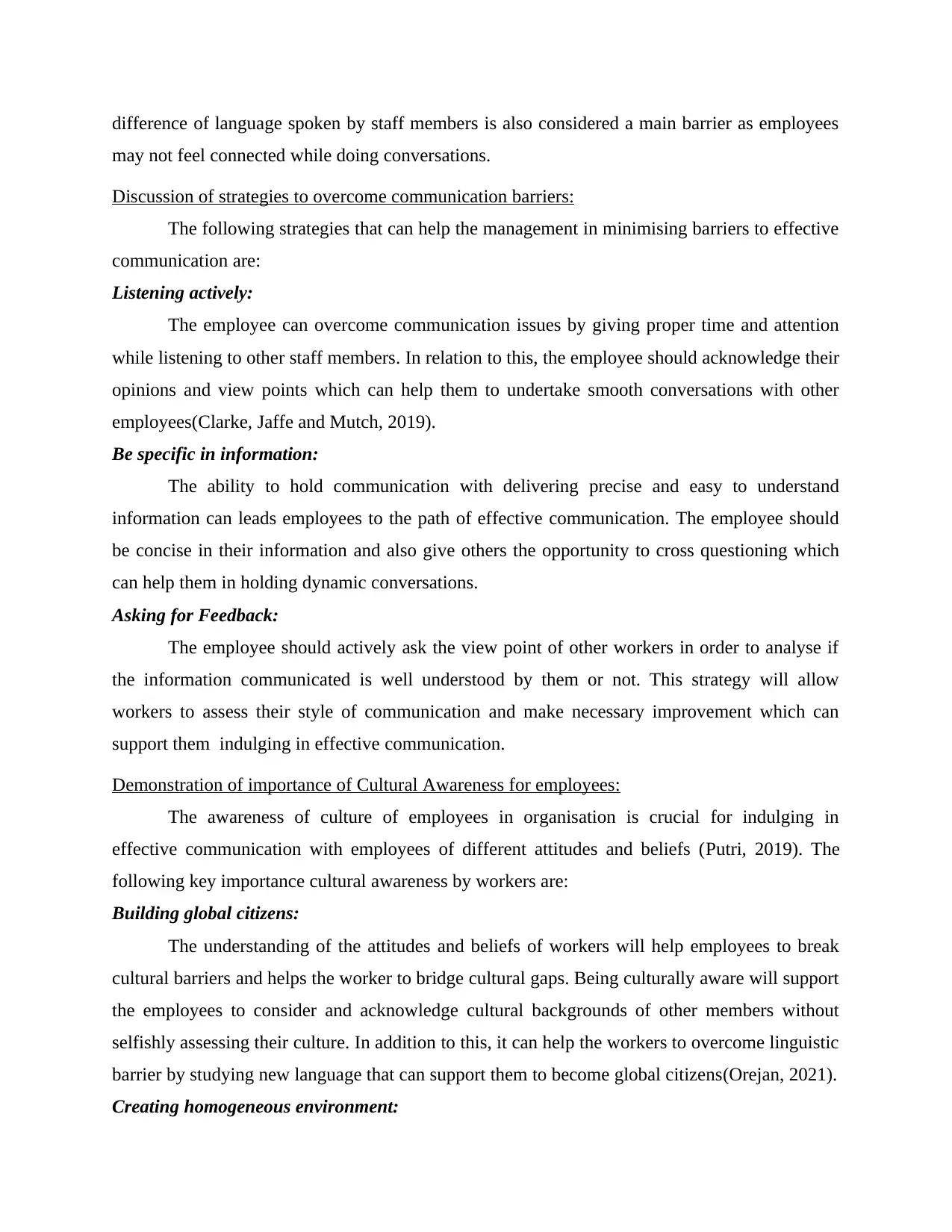
difference of language spoken by staff members is also considered a main barrier as employees
may not feel connected while doing conversations.
Discussion of strategies to overcome communication barriers:
The following strategies that can help the management in minimising barriers to effective
communication are:
Listening actively:
The employee can overcome communication issues by giving proper time and attention
while listening to other staff members. In relation to this, the employee should acknowledge their
opinions and view points which can help them to undertake smooth conversations with other
employees(Clarke, Jaffe and Mutch, 2019).
Be specific in information:
The ability to hold communication with delivering precise and easy to understand
information can leads employees to the path of effective communication. The employee should
be concise in their information and also give others the opportunity to cross questioning which
can help them in holding dynamic conversations.
Asking for Feedback:
The employee should actively ask the view point of other workers in order to analyse if
the information communicated is well understood by them or not. This strategy will allow
workers to assess their style of communication and make necessary improvement which can
support them indulging in effective communication.
Demonstration of importance of Cultural Awareness for employees:
The awareness of culture of employees in organisation is crucial for indulging in
effective communication with employees of different attitudes and beliefs (Putri, 2019). The
following key importance cultural awareness by workers are:
Building global citizens:
The understanding of the attitudes and beliefs of workers will help employees to break
cultural barriers and helps the worker to bridge cultural gaps. Being culturally aware will support
the employees to consider and acknowledge cultural backgrounds of other members without
selfishly assessing their culture. In addition to this, it can help the workers to overcome linguistic
barrier by studying new language that can support them to become global citizens(Orejan, 2021).
Creating homogeneous environment:
may not feel connected while doing conversations.
Discussion of strategies to overcome communication barriers:
The following strategies that can help the management in minimising barriers to effective
communication are:
Listening actively:
The employee can overcome communication issues by giving proper time and attention
while listening to other staff members. In relation to this, the employee should acknowledge their
opinions and view points which can help them to undertake smooth conversations with other
employees(Clarke, Jaffe and Mutch, 2019).
Be specific in information:
The ability to hold communication with delivering precise and easy to understand
information can leads employees to the path of effective communication. The employee should
be concise in their information and also give others the opportunity to cross questioning which
can help them in holding dynamic conversations.
Asking for Feedback:
The employee should actively ask the view point of other workers in order to analyse if
the information communicated is well understood by them or not. This strategy will allow
workers to assess their style of communication and make necessary improvement which can
support them indulging in effective communication.
Demonstration of importance of Cultural Awareness for employees:
The awareness of culture of employees in organisation is crucial for indulging in
effective communication with employees of different attitudes and beliefs (Putri, 2019). The
following key importance cultural awareness by workers are:
Building global citizens:
The understanding of the attitudes and beliefs of workers will help employees to break
cultural barriers and helps the worker to bridge cultural gaps. Being culturally aware will support
the employees to consider and acknowledge cultural backgrounds of other members without
selfishly assessing their culture. In addition to this, it can help the workers to overcome linguistic
barrier by studying new language that can support them to become global citizens(Orejan, 2021).
Creating homogeneous environment:
Paraphrase This Document
Need a fresh take? Get an instant paraphrase of this document with our AI Paraphraser
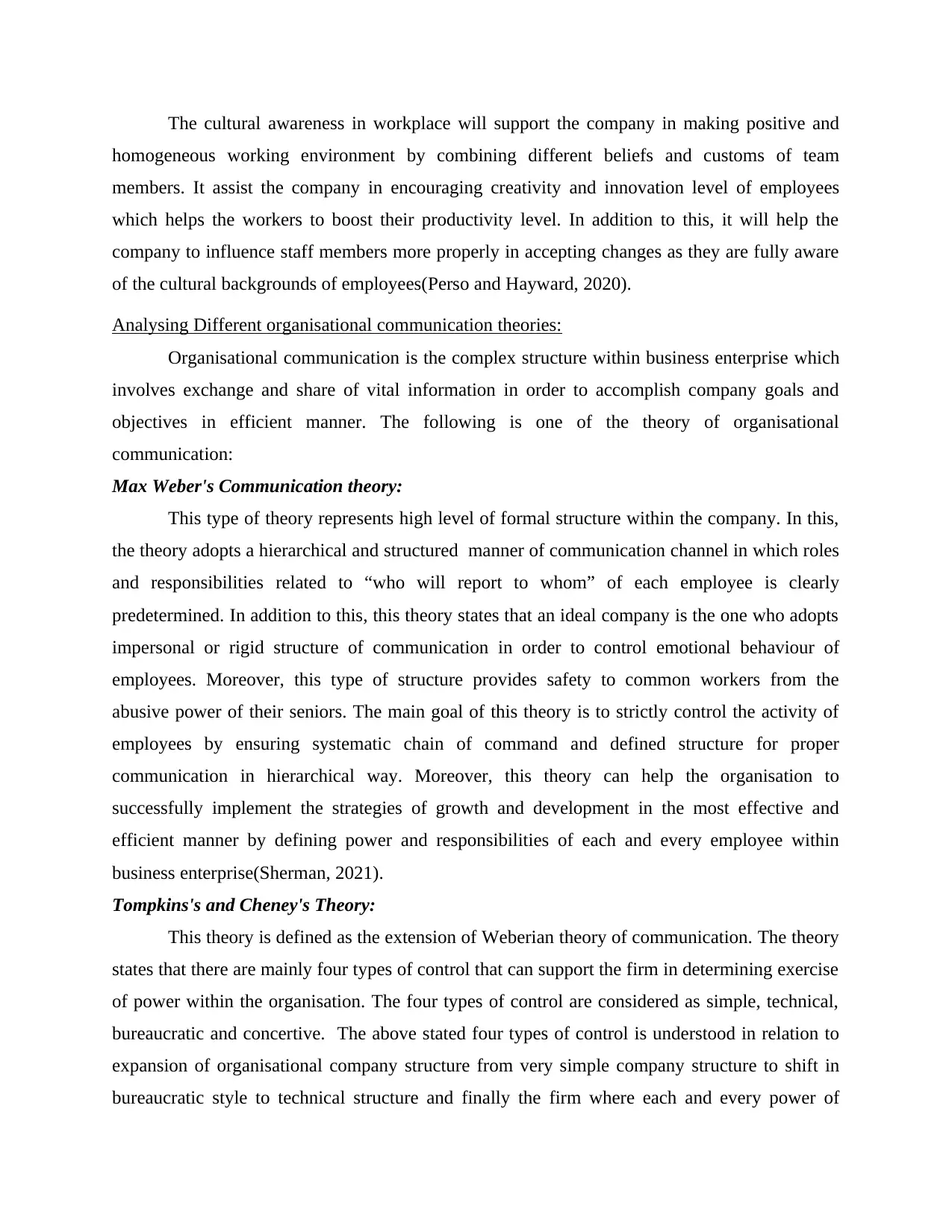
The cultural awareness in workplace will support the company in making positive and
homogeneous working environment by combining different beliefs and customs of team
members. It assist the company in encouraging creativity and innovation level of employees
which helps the workers to boost their productivity level. In addition to this, it will help the
company to influence staff members more properly in accepting changes as they are fully aware
of the cultural backgrounds of employees(Perso and Hayward, 2020).
Analysing Different organisational communication theories:
Organisational communication is the complex structure within business enterprise which
involves exchange and share of vital information in order to accomplish company goals and
objectives in efficient manner. The following is one of the theory of organisational
communication:
Max Weber's Communication theory:
This type of theory represents high level of formal structure within the company. In this,
the theory adopts a hierarchical and structured manner of communication channel in which roles
and responsibilities related to “who will report to whom” of each employee is clearly
predetermined. In addition to this, this theory states that an ideal company is the one who adopts
impersonal or rigid structure of communication in order to control emotional behaviour of
employees. Moreover, this type of structure provides safety to common workers from the
abusive power of their seniors. The main goal of this theory is to strictly control the activity of
employees by ensuring systematic chain of command and defined structure for proper
communication in hierarchical way. Moreover, this theory can help the organisation to
successfully implement the strategies of growth and development in the most effective and
efficient manner by defining power and responsibilities of each and every employee within
business enterprise(Sherman, 2021).
Tompkins's and Cheney's Theory:
This theory is defined as the extension of Weberian theory of communication. The theory
states that there are mainly four types of control that can support the firm in determining exercise
of power within the organisation. The four types of control are considered as simple, technical,
bureaucratic and concertive. The above stated four types of control is understood in relation to
expansion of organisational company structure from very simple company structure to shift in
bureaucratic style to technical structure and finally the firm where each and every power of
homogeneous working environment by combining different beliefs and customs of team
members. It assist the company in encouraging creativity and innovation level of employees
which helps the workers to boost their productivity level. In addition to this, it will help the
company to influence staff members more properly in accepting changes as they are fully aware
of the cultural backgrounds of employees(Perso and Hayward, 2020).
Analysing Different organisational communication theories:
Organisational communication is the complex structure within business enterprise which
involves exchange and share of vital information in order to accomplish company goals and
objectives in efficient manner. The following is one of the theory of organisational
communication:
Max Weber's Communication theory:
This type of theory represents high level of formal structure within the company. In this,
the theory adopts a hierarchical and structured manner of communication channel in which roles
and responsibilities related to “who will report to whom” of each employee is clearly
predetermined. In addition to this, this theory states that an ideal company is the one who adopts
impersonal or rigid structure of communication in order to control emotional behaviour of
employees. Moreover, this type of structure provides safety to common workers from the
abusive power of their seniors. The main goal of this theory is to strictly control the activity of
employees by ensuring systematic chain of command and defined structure for proper
communication in hierarchical way. Moreover, this theory can help the organisation to
successfully implement the strategies of growth and development in the most effective and
efficient manner by defining power and responsibilities of each and every employee within
business enterprise(Sherman, 2021).
Tompkins's and Cheney's Theory:
This theory is defined as the extension of Weberian theory of communication. The theory
states that there are mainly four types of control that can support the firm in determining exercise
of power within the organisation. The four types of control are considered as simple, technical,
bureaucratic and concertive. The above stated four types of control is understood in relation to
expansion of organisational company structure from very simple company structure to shift in
bureaucratic style to technical structure and finally the firm where each and every power of
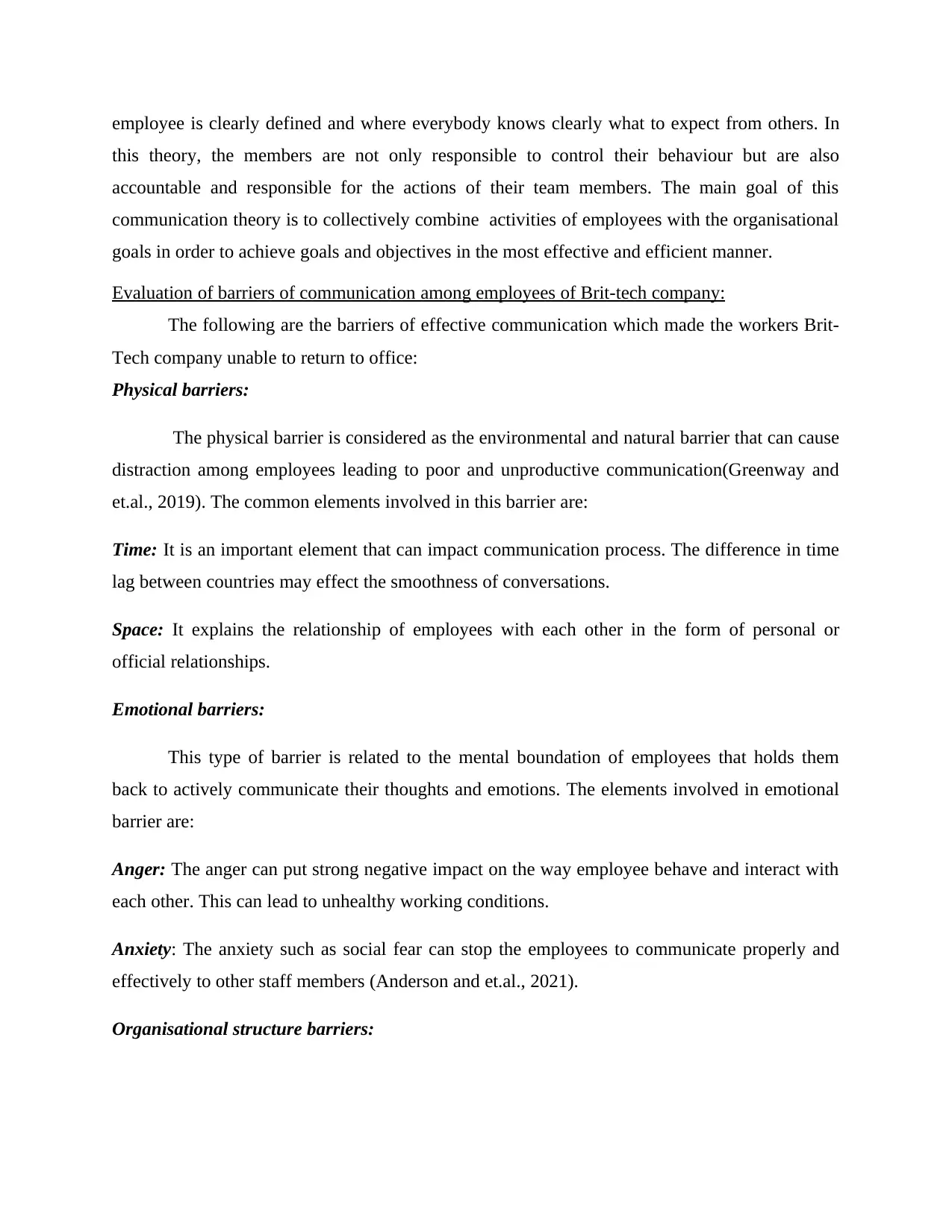
employee is clearly defined and where everybody knows clearly what to expect from others. In
this theory, the members are not only responsible to control their behaviour but are also
accountable and responsible for the actions of their team members. The main goal of this
communication theory is to collectively combine activities of employees with the organisational
goals in order to achieve goals and objectives in the most effective and efficient manner.
Evaluation of barriers of communication among employees of Brit-tech company:
The following are the barriers of effective communication which made the workers Brit-
Tech company unable to return to office:
Physical barriers:
The physical barrier is considered as the environmental and natural barrier that can cause
distraction among employees leading to poor and unproductive communication(Greenway and
et.al., 2019). The common elements involved in this barrier are:
Time: It is an important element that can impact communication process. The difference in time
lag between countries may effect the smoothness of conversations.
Space: It explains the relationship of employees with each other in the form of personal or
official relationships.
Emotional barriers:
This type of barrier is related to the mental boundation of employees that holds them
back to actively communicate their thoughts and emotions. The elements involved in emotional
barrier are:
Anger: The anger can put strong negative impact on the way employee behave and interact with
each other. This can lead to unhealthy working conditions.
Anxiety: The anxiety such as social fear can stop the employees to communicate properly and
effectively to other staff members (Anderson and et.al., 2021).
Organisational structure barriers:
this theory, the members are not only responsible to control their behaviour but are also
accountable and responsible for the actions of their team members. The main goal of this
communication theory is to collectively combine activities of employees with the organisational
goals in order to achieve goals and objectives in the most effective and efficient manner.
Evaluation of barriers of communication among employees of Brit-tech company:
The following are the barriers of effective communication which made the workers Brit-
Tech company unable to return to office:
Physical barriers:
The physical barrier is considered as the environmental and natural barrier that can cause
distraction among employees leading to poor and unproductive communication(Greenway and
et.al., 2019). The common elements involved in this barrier are:
Time: It is an important element that can impact communication process. The difference in time
lag between countries may effect the smoothness of conversations.
Space: It explains the relationship of employees with each other in the form of personal or
official relationships.
Emotional barriers:
This type of barrier is related to the mental boundation of employees that holds them
back to actively communicate their thoughts and emotions. The elements involved in emotional
barrier are:
Anger: The anger can put strong negative impact on the way employee behave and interact with
each other. This can lead to unhealthy working conditions.
Anxiety: The anxiety such as social fear can stop the employees to communicate properly and
effectively to other staff members (Anderson and et.al., 2021).
Organisational structure barriers:
⊘ This is a preview!⊘
Do you want full access?
Subscribe today to unlock all pages.

Trusted by 1+ million students worldwide
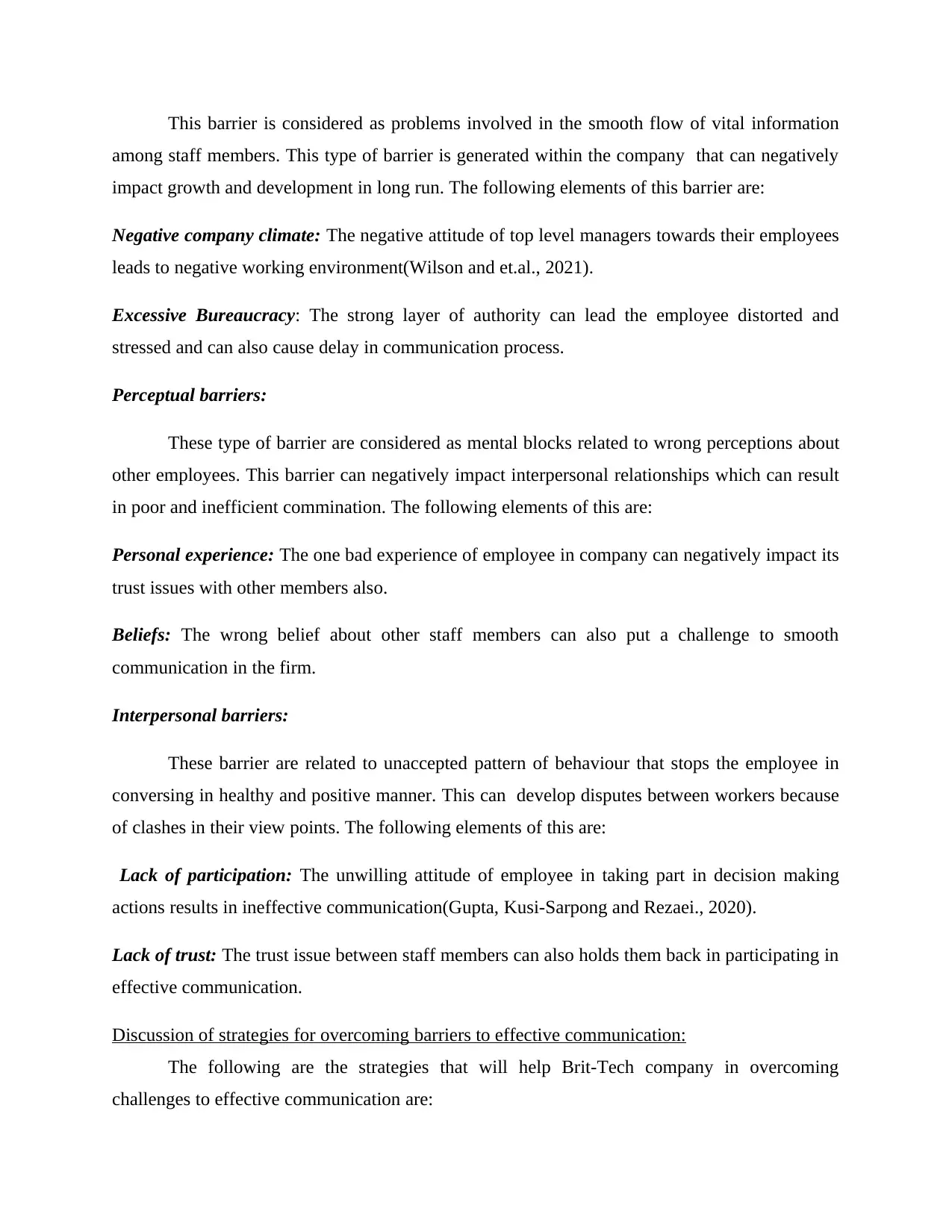
This barrier is considered as problems involved in the smooth flow of vital information
among staff members. This type of barrier is generated within the company that can negatively
impact growth and development in long run. The following elements of this barrier are:
Negative company climate: The negative attitude of top level managers towards their employees
leads to negative working environment(Wilson and et.al., 2021).
Excessive Bureaucracy: The strong layer of authority can lead the employee distorted and
stressed and can also cause delay in communication process.
Perceptual barriers:
These type of barrier are considered as mental blocks related to wrong perceptions about
other employees. This barrier can negatively impact interpersonal relationships which can result
in poor and inefficient commination. The following elements of this are:
Personal experience: The one bad experience of employee in company can negatively impact its
trust issues with other members also.
Beliefs: The wrong belief about other staff members can also put a challenge to smooth
communication in the firm.
Interpersonal barriers:
These barrier are related to unaccepted pattern of behaviour that stops the employee in
conversing in healthy and positive manner. This can develop disputes between workers because
of clashes in their view points. The following elements of this are:
Lack of participation: The unwilling attitude of employee in taking part in decision making
actions results in ineffective communication(Gupta, Kusi-Sarpong and Rezaei., 2020).
Lack of trust: The trust issue between staff members can also holds them back in participating in
effective communication.
Discussion of strategies for overcoming barriers to effective communication:
The following are the strategies that will help Brit-Tech company in overcoming
challenges to effective communication are:
among staff members. This type of barrier is generated within the company that can negatively
impact growth and development in long run. The following elements of this barrier are:
Negative company climate: The negative attitude of top level managers towards their employees
leads to negative working environment(Wilson and et.al., 2021).
Excessive Bureaucracy: The strong layer of authority can lead the employee distorted and
stressed and can also cause delay in communication process.
Perceptual barriers:
These type of barrier are considered as mental blocks related to wrong perceptions about
other employees. This barrier can negatively impact interpersonal relationships which can result
in poor and inefficient commination. The following elements of this are:
Personal experience: The one bad experience of employee in company can negatively impact its
trust issues with other members also.
Beliefs: The wrong belief about other staff members can also put a challenge to smooth
communication in the firm.
Interpersonal barriers:
These barrier are related to unaccepted pattern of behaviour that stops the employee in
conversing in healthy and positive manner. This can develop disputes between workers because
of clashes in their view points. The following elements of this are:
Lack of participation: The unwilling attitude of employee in taking part in decision making
actions results in ineffective communication(Gupta, Kusi-Sarpong and Rezaei., 2020).
Lack of trust: The trust issue between staff members can also holds them back in participating in
effective communication.
Discussion of strategies for overcoming barriers to effective communication:
The following are the strategies that will help Brit-Tech company in overcoming
challenges to effective communication are:
Paraphrase This Document
Need a fresh take? Get an instant paraphrase of this document with our AI Paraphraser
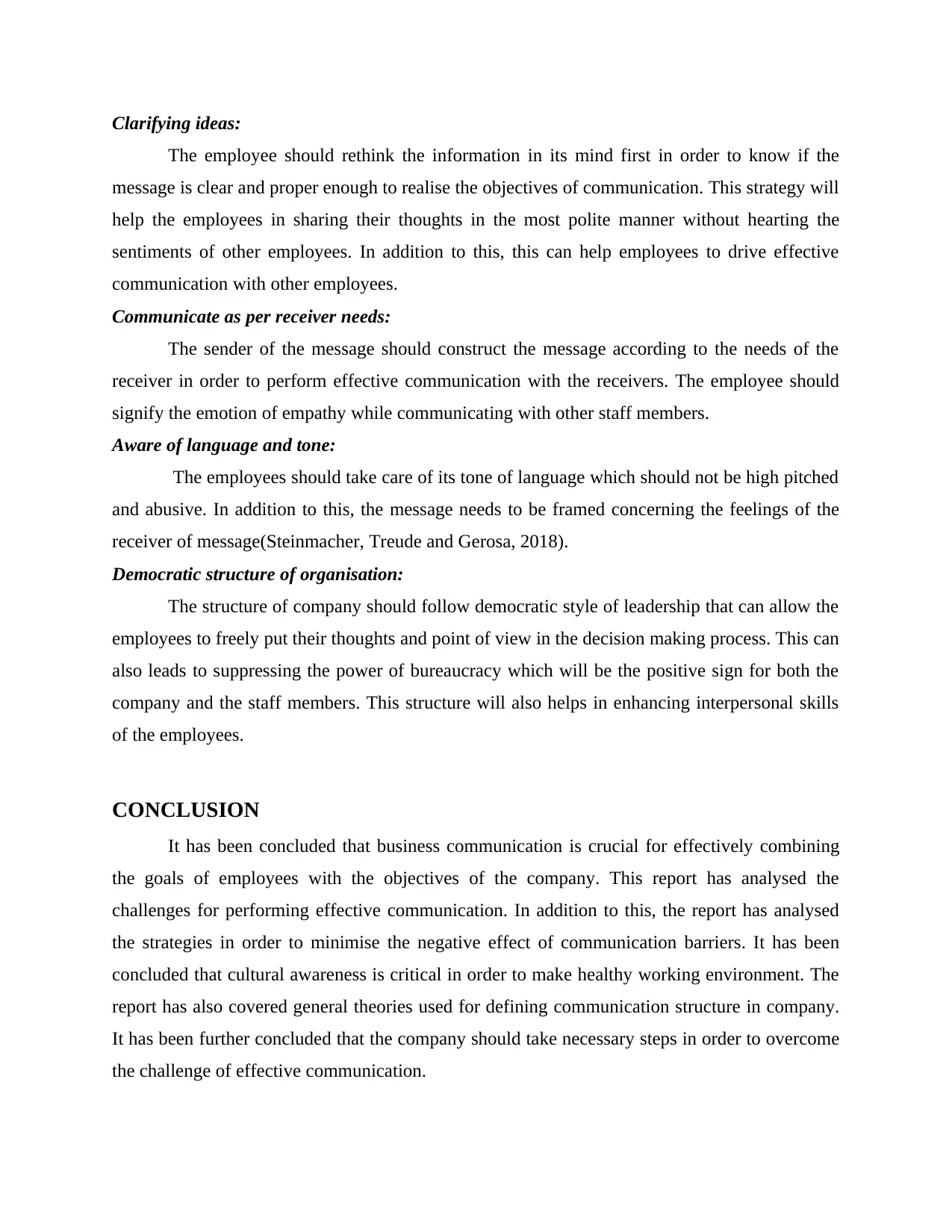
Clarifying ideas:
The employee should rethink the information in its mind first in order to know if the
message is clear and proper enough to realise the objectives of communication. This strategy will
help the employees in sharing their thoughts in the most polite manner without hearting the
sentiments of other employees. In addition to this, this can help employees to drive effective
communication with other employees.
Communicate as per receiver needs:
The sender of the message should construct the message according to the needs of the
receiver in order to perform effective communication with the receivers. The employee should
signify the emotion of empathy while communicating with other staff members.
Aware of language and tone:
The employees should take care of its tone of language which should not be high pitched
and abusive. In addition to this, the message needs to be framed concerning the feelings of the
receiver of message(Steinmacher, Treude and Gerosa, 2018).
Democratic structure of organisation:
The structure of company should follow democratic style of leadership that can allow the
employees to freely put their thoughts and point of view in the decision making process. This can
also leads to suppressing the power of bureaucracy which will be the positive sign for both the
company and the staff members. This structure will also helps in enhancing interpersonal skills
of the employees.
CONCLUSION
It has been concluded that business communication is crucial for effectively combining
the goals of employees with the objectives of the company. This report has analysed the
challenges for performing effective communication. In addition to this, the report has analysed
the strategies in order to minimise the negative effect of communication barriers. It has been
concluded that cultural awareness is critical in order to make healthy working environment. The
report has also covered general theories used for defining communication structure in company.
It has been further concluded that the company should take necessary steps in order to overcome
the challenge of effective communication.
The employee should rethink the information in its mind first in order to know if the
message is clear and proper enough to realise the objectives of communication. This strategy will
help the employees in sharing their thoughts in the most polite manner without hearting the
sentiments of other employees. In addition to this, this can help employees to drive effective
communication with other employees.
Communicate as per receiver needs:
The sender of the message should construct the message according to the needs of the
receiver in order to perform effective communication with the receivers. The employee should
signify the emotion of empathy while communicating with other staff members.
Aware of language and tone:
The employees should take care of its tone of language which should not be high pitched
and abusive. In addition to this, the message needs to be framed concerning the feelings of the
receiver of message(Steinmacher, Treude and Gerosa, 2018).
Democratic structure of organisation:
The structure of company should follow democratic style of leadership that can allow the
employees to freely put their thoughts and point of view in the decision making process. This can
also leads to suppressing the power of bureaucracy which will be the positive sign for both the
company and the staff members. This structure will also helps in enhancing interpersonal skills
of the employees.
CONCLUSION
It has been concluded that business communication is crucial for effectively combining
the goals of employees with the objectives of the company. This report has analysed the
challenges for performing effective communication. In addition to this, the report has analysed
the strategies in order to minimise the negative effect of communication barriers. It has been
concluded that cultural awareness is critical in order to make healthy working environment. The
report has also covered general theories used for defining communication structure in company.
It has been further concluded that the company should take necessary steps in order to overcome
the challenge of effective communication.
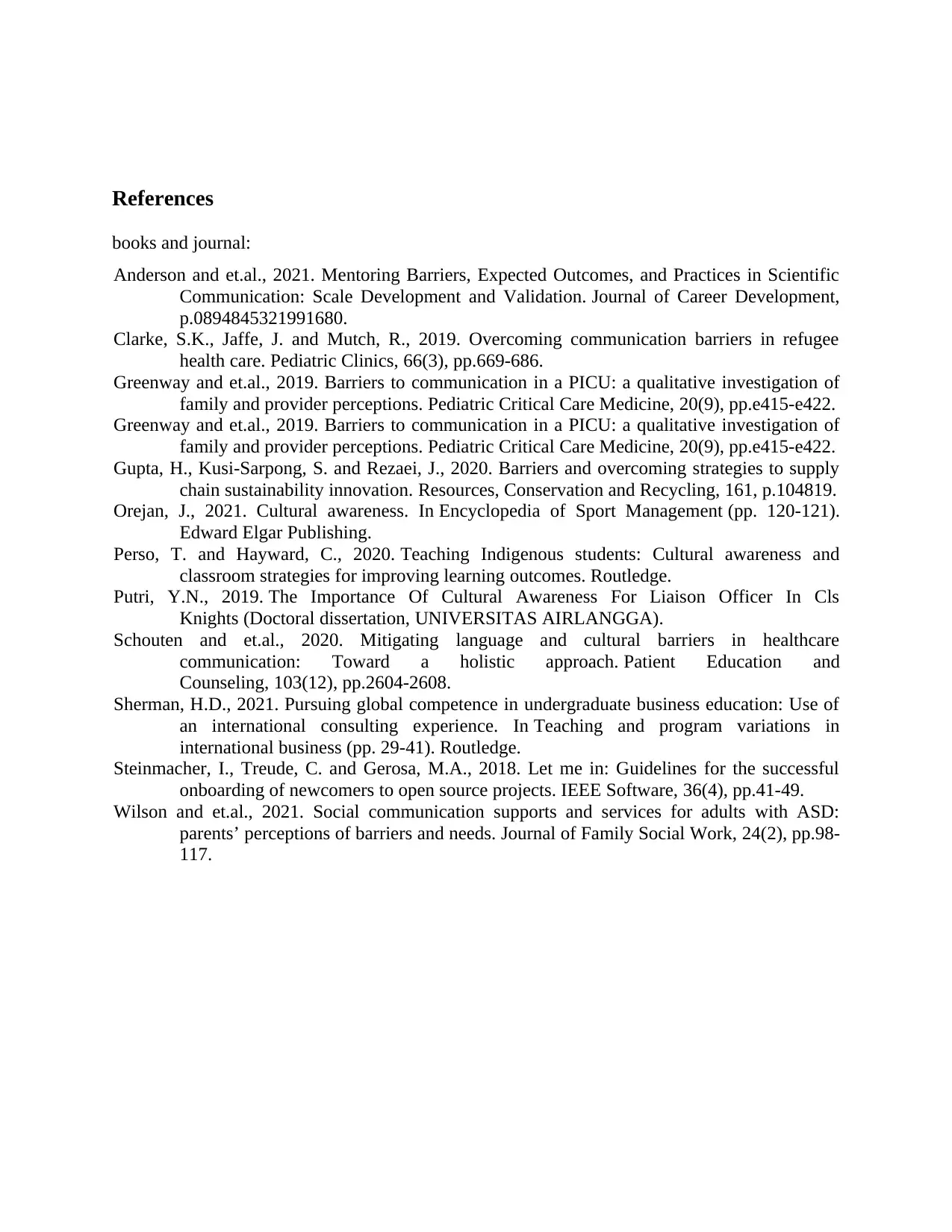
References
books and journal:
Anderson and et.al., 2021. Mentoring Barriers, Expected Outcomes, and Practices in Scientific
Communication: Scale Development and Validation. Journal of Career Development,
p.0894845321991680.
Clarke, S.K., Jaffe, J. and Mutch, R., 2019. Overcoming communication barriers in refugee
health care. Pediatric Clinics, 66(3), pp.669-686.
Greenway and et.al., 2019. Barriers to communication in a PICU: a qualitative investigation of
family and provider perceptions. Pediatric Critical Care Medicine, 20(9), pp.e415-e422.
Greenway and et.al., 2019. Barriers to communication in a PICU: a qualitative investigation of
family and provider perceptions. Pediatric Critical Care Medicine, 20(9), pp.e415-e422.
Gupta, H., Kusi-Sarpong, S. and Rezaei, J., 2020. Barriers and overcoming strategies to supply
chain sustainability innovation. Resources, Conservation and Recycling, 161, p.104819.
Orejan, J., 2021. Cultural awareness. In Encyclopedia of Sport Management (pp. 120-121).
Edward Elgar Publishing.
Perso, T. and Hayward, C., 2020. Teaching Indigenous students: Cultural awareness and
classroom strategies for improving learning outcomes. Routledge.
Putri, Y.N., 2019. The Importance Of Cultural Awareness For Liaison Officer In Cls
Knights (Doctoral dissertation, UNIVERSITAS AIRLANGGA).
Schouten and et.al., 2020. Mitigating language and cultural barriers in healthcare
communication: Toward a holistic approach. Patient Education and
Counseling, 103(12), pp.2604-2608.
Sherman, H.D., 2021. Pursuing global competence in undergraduate business education: Use of
an international consulting experience. In Teaching and program variations in
international business (pp. 29-41). Routledge.
Steinmacher, I., Treude, C. and Gerosa, M.A., 2018. Let me in: Guidelines for the successful
onboarding of newcomers to open source projects. IEEE Software, 36(4), pp.41-49.
Wilson and et.al., 2021. Social communication supports and services for adults with ASD:
parents’ perceptions of barriers and needs. Journal of Family Social Work, 24(2), pp.98-
117.
books and journal:
Anderson and et.al., 2021. Mentoring Barriers, Expected Outcomes, and Practices in Scientific
Communication: Scale Development and Validation. Journal of Career Development,
p.0894845321991680.
Clarke, S.K., Jaffe, J. and Mutch, R., 2019. Overcoming communication barriers in refugee
health care. Pediatric Clinics, 66(3), pp.669-686.
Greenway and et.al., 2019. Barriers to communication in a PICU: a qualitative investigation of
family and provider perceptions. Pediatric Critical Care Medicine, 20(9), pp.e415-e422.
Greenway and et.al., 2019. Barriers to communication in a PICU: a qualitative investigation of
family and provider perceptions. Pediatric Critical Care Medicine, 20(9), pp.e415-e422.
Gupta, H., Kusi-Sarpong, S. and Rezaei, J., 2020. Barriers and overcoming strategies to supply
chain sustainability innovation. Resources, Conservation and Recycling, 161, p.104819.
Orejan, J., 2021. Cultural awareness. In Encyclopedia of Sport Management (pp. 120-121).
Edward Elgar Publishing.
Perso, T. and Hayward, C., 2020. Teaching Indigenous students: Cultural awareness and
classroom strategies for improving learning outcomes. Routledge.
Putri, Y.N., 2019. The Importance Of Cultural Awareness For Liaison Officer In Cls
Knights (Doctoral dissertation, UNIVERSITAS AIRLANGGA).
Schouten and et.al., 2020. Mitigating language and cultural barriers in healthcare
communication: Toward a holistic approach. Patient Education and
Counseling, 103(12), pp.2604-2608.
Sherman, H.D., 2021. Pursuing global competence in undergraduate business education: Use of
an international consulting experience. In Teaching and program variations in
international business (pp. 29-41). Routledge.
Steinmacher, I., Treude, C. and Gerosa, M.A., 2018. Let me in: Guidelines for the successful
onboarding of newcomers to open source projects. IEEE Software, 36(4), pp.41-49.
Wilson and et.al., 2021. Social communication supports and services for adults with ASD:
parents’ perceptions of barriers and needs. Journal of Family Social Work, 24(2), pp.98-
117.
⊘ This is a preview!⊘
Do you want full access?
Subscribe today to unlock all pages.

Trusted by 1+ million students worldwide

Paraphrase This Document
Need a fresh take? Get an instant paraphrase of this document with our AI Paraphraser


⊘ This is a preview!⊘
Do you want full access?
Subscribe today to unlock all pages.

Trusted by 1+ million students worldwide
1 out of 12
Related Documents
Your All-in-One AI-Powered Toolkit for Academic Success.
+13062052269
info@desklib.com
Available 24*7 on WhatsApp / Email
![[object Object]](/_next/static/media/star-bottom.7253800d.svg)
Unlock your academic potential
Copyright © 2020–2025 A2Z Services. All Rights Reserved. Developed and managed by ZUCOL.



